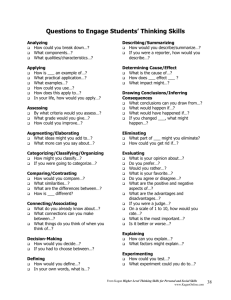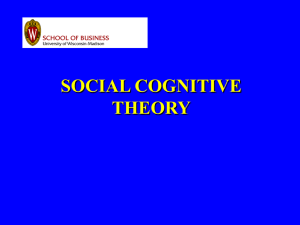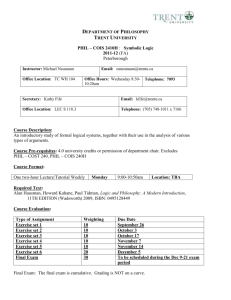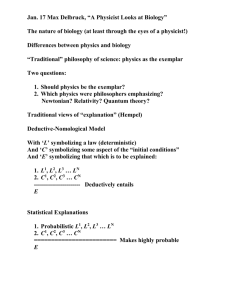Symbolizing Students: Striving Towards Completion by
advertisement
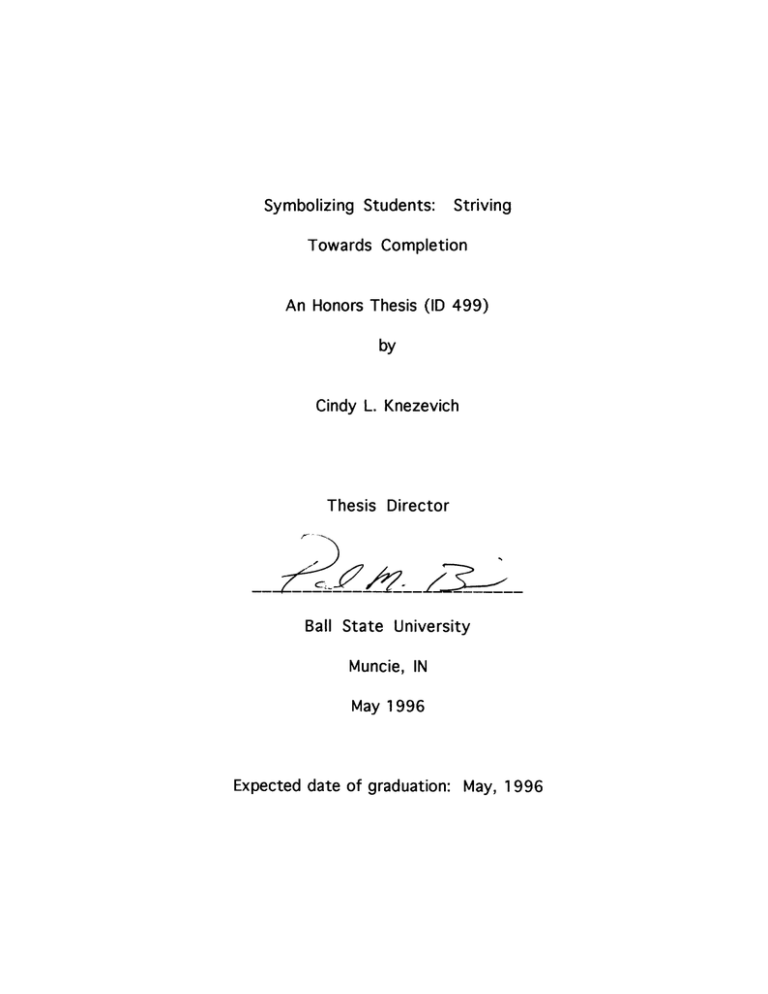
Symbolizing Students: Striving Towards Completion An Honors Thesis (lD 499) by Cindy L. Knezevich Thesis Director Ball State University Muncie, IN May 1996 Expected date of graduation: May, 1996 '711 1 , __, Symbolizing Students 1 , ,'C> 10.), I KEff Symbolizing Students: Striving Towards Completion Cindy L. Knezevich Ball State University Running head: SYMBOLIZING STUDENTS Symbolizing Students 2 Abstract People often reveal their identities and aspirations to others for important underlying reasons. Outwardly showing others the identity one is striving for has been labeled "symbolic self-completion" in past research efforts. The present study applied this notion to college students. That is, we attempted to determine if students who are committed to being a student and are incomplete with their identities as "students" tend to symbolize to others. Two hundred and seventy-eight undergraduate college students completed a questionnaire measuring their commitment to the goal of being a good student and their symbolizing behavior. High school grade point average was used as an index of role identity completion. Correlations were performed on responses to each of the symbolizing behavior questions and high school grade point average for both committed and uncommitted students. Negative relationships were expected between the symbolizing questions and high school grade point average, but only for those students who were committed to their roles. Several relationships were statistically significant and are discussed. The overall results of the study did not support the theory. Symbolizing Students 3 Symbolizing Students: Striving Towards Completion In today's society people are often seeking approval or acknowledgement from others to feel accepted or part of society. Through this process, they search within themselves for an identity, one that is separate and unique, yet similar to the norms of society. Striving for a certain identity stems from an internal unfinished. "incompleteness," something left People often show others outwardly that they are incomplete and working towards a particular identity through "symbolizing." Wicklund and Gollwitzer (1982) have studied such "symbolic selfcompletion" concept among athletes, mothers, and other groups. For example, a young athlete trying to become a professional football player may symbolize in a number of ways. He eats to gain body mass, practices and plays the sport for recognition, wears a ring or pin showing past achievements, and "hangs out" with the pro players. By these actions and signs, he attempts either consciously or unconsciously to fill in the gap between his current identity and his desired identity. Moreover, his symbolizing will often result in others seeing him as more competent than he actually is. Symbolizing Students 4 The theory of symbolic self-completion is based on several of Kurt Lewin's propositions (1935). Specifically, Lewin developed a paradigm describing the attainment of psychological goals through tension systems. In brief, when an organism is in pursuit of a goal, a tension system is initiated within the organism which produces a state of energization directed toward attaining the goal. Zeigarnik (1927) and Ovsiankina (1928) conducted experiments in which goal-directed behaviors were interrupted. Theoretically, such interruptions should result in behaviors that manifest the internal tension system. The results of the Ovsiankina (1928) study supported this notion in that subjects showed an impulse to continue goal-directed activities that were interrupted. Moreover, activities that were not yet completed were also retained better in memory (Zeigarnik, 1927). Symbolic self-completion theory incorporates the Lewinian notion of tension systems. In particular, the theory proposes that when individuals are committed to a particular identity, a tension system results. The tension, then, provides the motivation toward the fulfilled identity. Of course, when the identity is attained, the tension dissipates. But, until this happens (i.e., while one is striving toward the identity), the Symbolizing Students 5 tension is at full force. Wicklund and Gollwitzer (1982) argue that symbolic self-completion (Le., showing others, through symbols, that one has attained the completed identity) is simply a by-product of the tension system. In a supporting study, Wicklund and Gollwitzer (1982) gave undergraduate students the task of writing an essay and the chance for the essay to be published. In one condition, the students were allowed to complete the task (control group); in the other condition students were interrupted in the middle of the task. Both groups, were then asked to estimate how many mistakes they thought they had made while writing the essay. The interrupted group, presumably in a tension state because of the unfinished task, reported making fewer mistakes than the control group. In another study, female students were asked to report of how physically fit they thought they were. After answering a number of pertinent questions, the females were placed in one of four groups, depending on their level of commitment to being physically fit. As expected, those in the highly-committed group tended to exaggerate their self-descriptions the most in an effort to make themselves appear to be • Symbolizing Students 6 in the best shape, regardless of their actual level of physical fitness (Wicklund and Gollwitzer, '982). In the present study, it was hypothesized that college students who felt incomplete as college students would symbolically self-complete. That is, these students were expected to symbolize to other students by "hanging out" around campus more, attending more social and sporting events, wearing clothes with the university logo, and the like. It was predicted that, among highly-committed students, those who were less complete in terms of their academic competence would be more likely to symbolize than those students more complete in terms of their academic competence. Methods Subjects Two hundred and eighty-four students participated in the study as part of their introductory psychology course requirement. There were 176 males and 108 females (average age = 18). Symbolizing Students 7 Questionnaire Each subject, after reporting general anonymous demographic information, answered questions regarding their symbolizing behavior, mostly rating questions from 1="never" to 9="always" (e.g. "To what extent do you generally participate in class discussions when they occur?"); some being yes/no questions ("Do you regularly attend Ball State sporting events?"). Commitment was measured by asking students to report the extent to which they stayed up on the required reading for their courses (1 ="not at all" to 9="very much"). High school grade point average was used as a measure of academic competence. The original questionnaire and the variable names used for data analYSis (see right-hand column) are depicted in Appendix A. Procedure A male experimenter distributed the questionnaires to 1 5 separate groups of subjects over a period of a several weeks toward the end of the semester. Subjects met in a large lecture hall, completed the questionnaires in approximately 15 minutes, and quietly left the room when finished. Symbolizing Students 8 Results It was expected that, among the committed students, those who were striving to be complete in their roles as "students" (those with lower high school grade point averages) would symbolize more than students who were already complete in the role (those with higher high school grade point averages). Commitment to the identity was operationalized using the item: "How often do you tend to stay up on the required reading for your courses?" (Answers ranged from 1="not at all" to 9="very much."). Committed students were presumed to stay up on the required reading for their courses (>5) whereas uncommitted students were presumed not to do so «5). Two separate groups of correlations were performed, first between high school grade point average and symbolizing behavior responses among the committed students, and next, between high school grade point average and symbolizing behavior responses among the uncommitted students. Four significant correlations were found among the uncommitted students, i.e. between high school grade point average and responses to: BSUOWN1, [(280) = .26, Q < .05; BSUBUY1, [(279) = .23, Q < .05; COMMENC, [(281 ) = .23, Q < .05; PICTURE, [(276) = .22, Q < .05. See Appendix A for full questions. No significant Symbolizing Students 9 relationships were found among the committed group of students. These results suggest that uncommitted students with higher high school grade point averages owned more university items/clothing, personally bought these items/clothing, planned on going through the commencement ceremonies upon graduation, and planned on having their picture in the annual yearbook. Insert Table 1 about here Discussion Symbolic self-completion theory was proposed to be applied to a broad range of individuals, given their sense of commitment to an identity goal. We attempted to show that committed yet incomplete (low grade point average) college students are subject to this process, symbolizing to others as "students" by wearing clothes with the university's logo on them, attending sporting events, and having university stickers on their cars to name a few. However, the expected results did not prove to be significant. That is, the theory was not supported when applied to symbolizing behaviors of college students. The relationships that did achieve statistical significance (Q < .05) Symbolizing Students 10 were limited and showed that uncommitted students with high grade point averages personally bought and owned more clothes with the university's logo on them, had a greater desire to go through commencement ceremonies, and tended to want to have their picture in the yearbook moreso than the other subjects. One possible explanation for these unexpected results is that the uncommitted students with higher grade point averages may not have stayed up on their required reading to actually "f it in." That is, they wanted other students to recognize them for not only how smart they were, but also for how much of a "normal" student they could be. In this vein, they would also be expected to wear clothes with the university's logo on them and the like. In other words, these uncommitted students may have used the "symbolizing" behaviors to a higher extent than the committed students because they are trying harder to fit into the "norm;" not wanting to appear overly smart and "nerdy." The null effects of the study could stem from a number of possibilities. First, when evaluating the questionnaire itself, the questions measuring symbolizing behavior might not have directly pinpointed the way in which students symbolize. Buying and wearing Symbolizing Students 11 university clothes, for example, are standard behaviors for most college students. That is, wearing university clothes may be the norm or the "thing to do" when living on campus. Thus, our symbolizing questions may have been too general, which in turn, would limit the variability among the students' responses. And, in fact, this was the case for at least some of the symbolizing measures. Second, students who completed the questionnaire did so to fulfill an introductory psychology course requirement. Since the majority of these students were freshmen, it may have been too early for them to develop a sense of commitment yet. Being new on campus, many students are away from home and on their own for the first time. Besides school, students have to take on many new responsibilities and get comfortable with this new stage in their lives. The first semester or two involves meeting new people, making new friends, and getting in touch with university life in general. By the second or third year, students are likely concentrating more on their school work and grades; deciding whether or not to commit themselves to being "college students." Although our study made a reasonably good attempt to detemine how college students, in general, symbolize, future researchers may consider Symbolizing Students 12 assessing more specific college populations, such as students in certain fields/majors or even professors in different departments. A larger sample of fraternity and sorority members might also be used to obtain a more accurate description of how these particular students symbolize. In addition, there are many diverse groups of students on college campuses, such as religious organizations and ethnic organizations. Symbolizing behaviors of these and other groups might be more evident and easier to measure. Symbolizing Students 13 References Lewin, K. A Dynamic Theory of Personality. New York: McGraw-Hili, 1935. Ovsiankina, M. Die Wiederaufnahme unterbrochener Handlungen. In A. Van Bergen, Task interruption. Amsterdam: North-Holland Publishing Co., 1968. Wicklund, R. A., and Gollwitzer, P. M. (1982). Symbolic Self-Completion. New Jersey: Lawrence Erlbaum Associates. Zeigarnik, B. Das Behalten erledigter und unerledigter Handlungen. In A. Van Bergen, Task interruption. Amsterdam: North-Holland Publishing Co., 1968. Symbolizing Students 14 Table 1: Zero-order correlations between grade point average and reported symbolizing behaviors for committed and uncommitted subjects COMMITTED UNCOMMITTED BSUSTIK ,06 ,07 BSUOWN1 ,02 ,26* BSUBUY1 ,04 ,23* BSUWEAR ,13 ,12 BSUOWN2 ,08 ,06 BSUBUY2 ,06 ,08 GREEK ,01 ,07 GRKOWN1 ,10 ,39 GRKBUY1 ,17 ,39 GRKWEAR ,16 ,45 GRKOWN2 ,12 ,32 GRKBUY2 ,07 ,28 FRATCAR ,17 ,09 YOUPUT ,17 ,07 RING ,03 ,15 SPORTS ,04 ,07 COMMENC ,00 ,23* PICTURE ,03 ,22* YEARBOOK ,05 ,14 *These correlations are significant, .Q < ,05, Symbolizing Students 15 Appendix A Ball State University Survey Please answer the following questions as quickly and honestly as possible. If you cannot answer a particular question, you may leave it blank and go on to the next question. Be assured that your responses will be kept strictly confidential. To guarantee anonymity, we ask that you not write your name on the questionnaire. Thank you in advance for your cooperation. Female ___ Male __ _ SEX Age __ _ AGE College Major (if undeclared, leave blank) ____ _ MAJOR Year in college (check one): Freshman __ _ Sophomore __ _ Junior Senior Grad Student ___ Other YEAR Overall High School Grade Point Average (4.0 scale) __ _ HSGPA High School Class Rank (at graduation) __ _ RANK List all of the ACADEMIC (nonsports) honors, sholarships, fellowships, and awards that you have received over the last five years: __ _ AWARD List all of the ACADEMIC honor's clubs and societies of which you are or CLUBS were a member of during the last five years: ___ Symbolizing Students 16 The following is a list of reasons one might have for attending college. Please RANK these reasons from 1 to 7 as they pertain to why you personally are attending college. That is, a "1" should be placed next to the primary reason why you are attending college, a "2" should be placed next to the next most primary reason, and so on. I am attending college: ___ because my parents wanted me to go. PARNT ___ because my close friends were going. FRNDS ___ because alternative options Gob opportunities) were limited. NOJOB ___ to ultimately get a good job and be successful. SUCCES ___ to become an intelligent and well-educated person. SMART ___ to learn new things and become a well-rounded person. LEARN ___ to meet new people and socialize. SOCIAL To what extent do you like being a college student (circle one)? 1 2 not at all 3 4 5 6 7 8 9 very much LIKE Symbolizing Students 17 Do you tend to stay up on the required reading for your courses (circle one)? 1 2 3 4 5 6 7 8 9 very much not at all READ To what extent do you generally participate in class discussions when they occur (circle one)? 1 2 3 4 5 6 7 8 9 always never DISCUSS Do you usually show up more than five minutes early for your classes (circle one)? 1 2 3 4 5 6 7 8 never 9 always EARLY Estimate the percentage of your college costs that you are or will be personally paying for (either through loans that you will have to pay back or current part-time work). I am paying approximately ___ % of my college costs. COST To what extent do you go home on weekends (circle one)? 1 2 never 3 4 5 6 7 8 9 always HOME If you own or have primary use of a car, is there a Ball State University window or bumper sticker on it? yes ___ no __ _ BSUCAR Symbolizing Students 18 Did you personally put the sticker on the car? no __ _ yes __ _ BSUSTIK How many articles of clothing do you own that display Ball State's logo or the university's name on it? You should include t-shirts, polo shirts, sweatshirts, sweatpants, scarves, jackets, shorts, socks, caps, hats, and sweaters. I own ___ articles of Ball State clothing. BSUOWN1 Of these articles of clothing, how many did you actually buy yourself? BSUBUY1 To what extent do you wear the Ball State clothing that you own (circle one)? 1 2 3 4 5 6 7 8 never 9 always BSUWEAR How many nonclothing articles do you own that display Ball State's logo or the university's name on it? Such articles would include, but are not limited to, pins, jewelry, buttons, mugs, glasses, cups, pens, pencils, notebooks, bookbags, and folders. I own ___ nonclothing Ball State articles. BSUOWN2 Of these articles, how many did you actually buy yourself? I personally purchased ___ of these articles. BSUBUY2 Are you a member of a fraternity or sorority? yes __ _ no ___ GREEK Symbolizing Students 19 How many articles of clothing do you own that display your fraternity or sorority house's letters? You should include t-shirts, polo shirts, sweatshirts, sweatpants, scarves, jackets, shorts, socks, caps, hats, and sweaters. I own ___ articles of fraternity/sorority clothing. GRKOWN1 Of these articles, how many did you actually buy yourself? I personally purchased ___ of these articles. GRKBUY2 To what extent do you wear the fraternity/sorority clothing that you own (circle one)? 1 2 never 3 4 5 6 7 8 9 always GRKWEAR How many nonclothing articles do you own that display your fraternity/sorority house's letters? Such articles would include, but are not limited to , pins, jewelry, buttons, mugs, glasses, cups, pens, pencils, notebooks, bookbags, and folders. I own ___ nonclothing fraternity/sorority articles. GRKOWN2 Of these articles, how many did you actually buy yourself? I personally purchased ___ of these articles. GRKBUY2 If you own or have primary use of a car, is there a fraternity/sorority window sticker on it? yes __ _ no __ _ FRATCAR Did you personally put the sticker on it? yes __ _ no ___ YOU PUT Symbolizing Students 20 Do you plan on purchasing a college ring when you graduate? no __ _ yes __ _ RING Do you regularly attend Ball State sporting events? no __ _ yes ___ SPORTS Do you plan on going through graduation ceremonies when you graduate? no __ _ yes __ _ COMMENC Do you plan on having your picture in the Ball State Annual Yearbook? no __ _ yes __ _ PICTURE Do you plan on purchasing a Ball State Annual Yearbook? no __ _ yes __ _ YEARBK How often do you read/study at the university library? 1 never 2 3 4 5 6 7 8 9 always LBSTUDY Please take a few minutes and go through the questionnaire again to ensure the accuracy of your responses. Thank you again for your assistance with this research effort!
